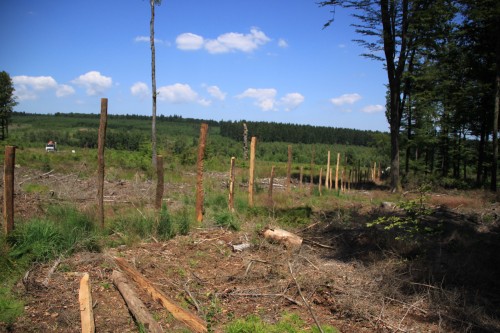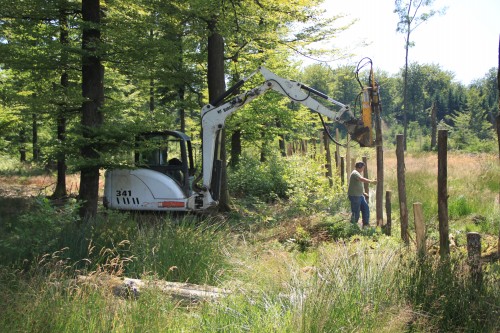|  |
C1. Removal of resinous trees
In the majority of cases, the wetland areas that are the object of the restoration works in the LIFE-Lomme project (heaths, low marshland, alluvial meadows, etc) have been cleared of resinous trees. Sometimes only on a limited scale with some natural spruce regeneration scattered throughout open areas but sometimes quite drastically with dense plantations of resinous trees. In the case of the latter, there are only a few small pockets of wetlands remaining.
The first stage in the restoration works therefore generally consists of removing the resinous trees, either manually (strimmer, chainsaw), or mechanically (e.g. rotary slashing).
Some video images illustrating rotary slashing of some young natural spruce seedlings in the immediate vicinity of the Troufferies de Libin RND (property of the Municipality of Libin):
VIDEO 1 (MOV-25979 ko)
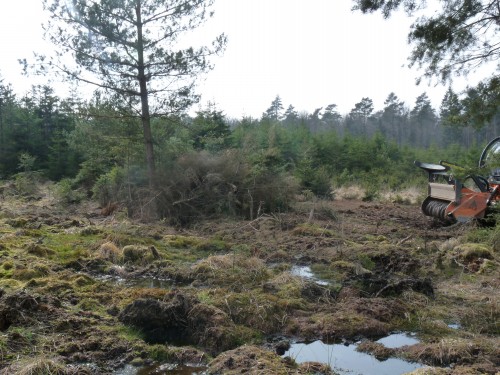
Rotary slashing of resinous trees.
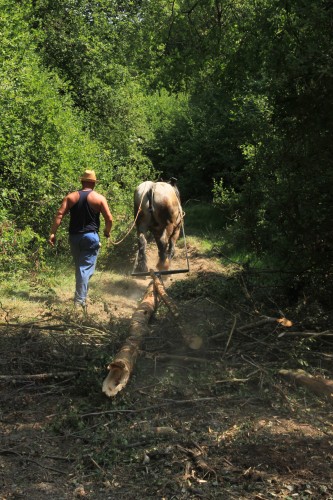
Logging of resinous trees with the assistance of draft horses (Fange Mariette)
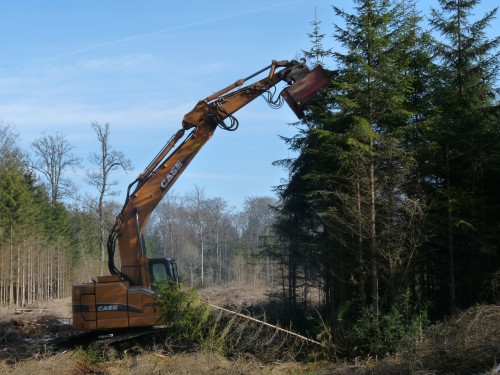
Rotary slashing of resinous trees.
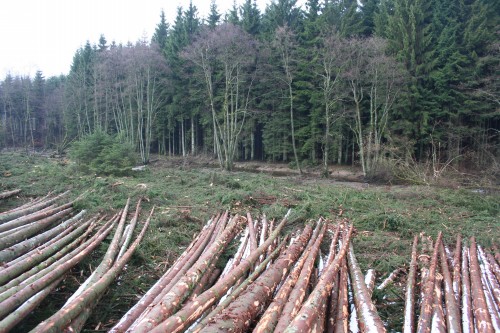
Removal of resinous trees from the bottom of the Lomme Valley downstream from Bras (Libramont).
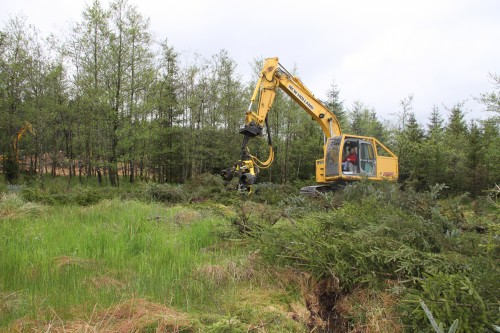
Rotary slashing of young resinous trees in the Noire Eau Valley (Libin).
C2. Soil moisture regime restoration
Resinous trees are known to evapotranspire large quantities of water. Simply by cutting them down the water table rises noticeably. But this is not always enough to restore the nature of the soil and therefore is not always enough to restore the environmental conditions that are necessary for ecological recovery in the areas in question. For wetlands and peatlands, a high water table level is necessary.
Spruce plantations on very wet soils were frequently accompanied by the digging of ditches to drain the ground. To raise the water table level and promote the recovery of the wetland and peatland, the drains must be blocked. Small clay plugs (taken from directly around the drain) are placed in the drain every 20 to 30 metres. At the points from which the clay is removed, a small depression forms which rapidly fills with water (forms a “mardelle”).
The creation of mineral dykes, arranged perpendicular to the slope of the land, allows a very shallow body of water to form thus offering conditions that are highly conducive to the development of plant species typical of peatlands (sphagnum moss, eriophorum, etc).
The two bodies of water that have been created by the techniques explained above are very shallow. It is interesting to complement these different bodies of water with pools that are intermediate in size when compared to mardelles and bodies of water that have been created by mineral ditches. Furthermore, the pools have a depth of approximately 1.50 metres, which prevents the pool from freezing over completely (and the fauna found there) during the winter months.
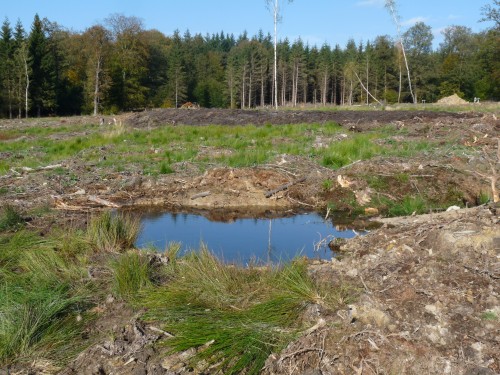
Mardelle resulting from the blocking of a drain.
C3. Revegetation works
In the places where the soil has been heavily reworked (turf stripping, scraping away the residues of rotary slashing, etc.), the species that are characteristic of peatland and low marsh find it difficult to take hold there because the soil is exposed to the sun and the wind causes ripples in bodies of water, etc. To speed up the return to typical vegetation, it is therefore necessary to recreate a favourable micro-climate. This may be achieved by transplanting what are known as “nurse” species, in other words, plants whose presence encourages the development of other plants. For example, eriophorum vaginatum forms mounds called tussocks which creates conditions that are conducive to the appearance of sphagnum moss (shade and moisture retention). The sphagnum moss firstly develops at the base of the tussock and from there it slowly colonises the remainder of the restored area of land.
With the assistance of two trainees, this spring the LIFE team proceeded to transplant the eriophorum vaginatum. The eriophorum was taken from the immediate vicinity of the zones that were to be revegetated. Just a few tussocks were enough to revegetate large areas as one tussock can be divided into a dozen small clumps.
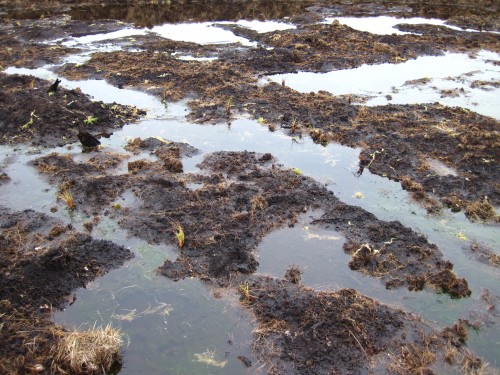
Planted Eriophorum..
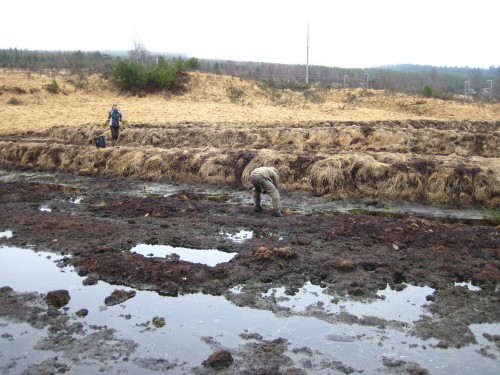
C4. Restoration of forest habitats and hardwood border areas
The hardwood forests opposite the open areas that were restored by removing the resinous trees and by aquatic restoration have not been overlooked in this project. A culmination of several factors led to a lack of natural regeneration of the forest in places and to a loss of diversity (see Biological challenges). In other words, the young beech or oak plants that could have served to renew the forest after their elders had been felled are missing or are too thin on the ground. The beech or oak “companion species” are also absent: mountain ash, birch, hornbeam, poplar, etc.
The technique that has been proposed to mitigate this degradation of the hardwood forest is relatively straightforward: several areas ranging from between 1 and 2 hectares situated in the degraded forest will be fenced off in order to prevent large herbivores from accessing them. In the places where our forests' companion species have disappeared, various species will be planted in the enclosure. These enclosure areas will then act as regeneration hubs and new plants can gradually propagate in the hardwood forest surrounding the enclosure.
The enclosures are temporary; they simply provide us with the assurance that the trees and shrubs will reach a height that is sufficient to render them less susceptible to being eaten by game animals.
July 2013 – the first enclosures aimed at created and protecting these regeneration hubs of the hardwood forest are to be found in the area around the Troufferies de Libin, on municipal property.
